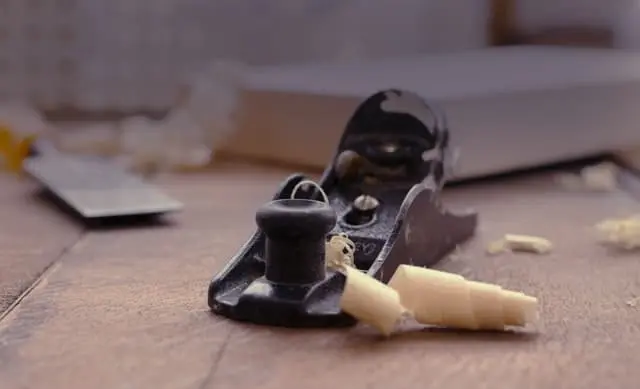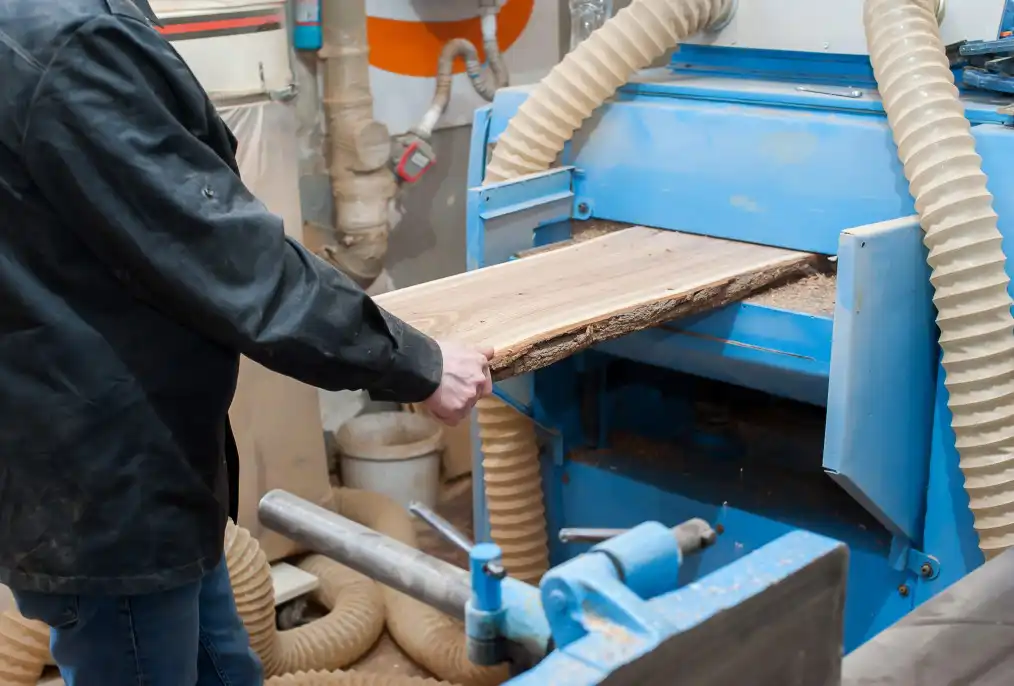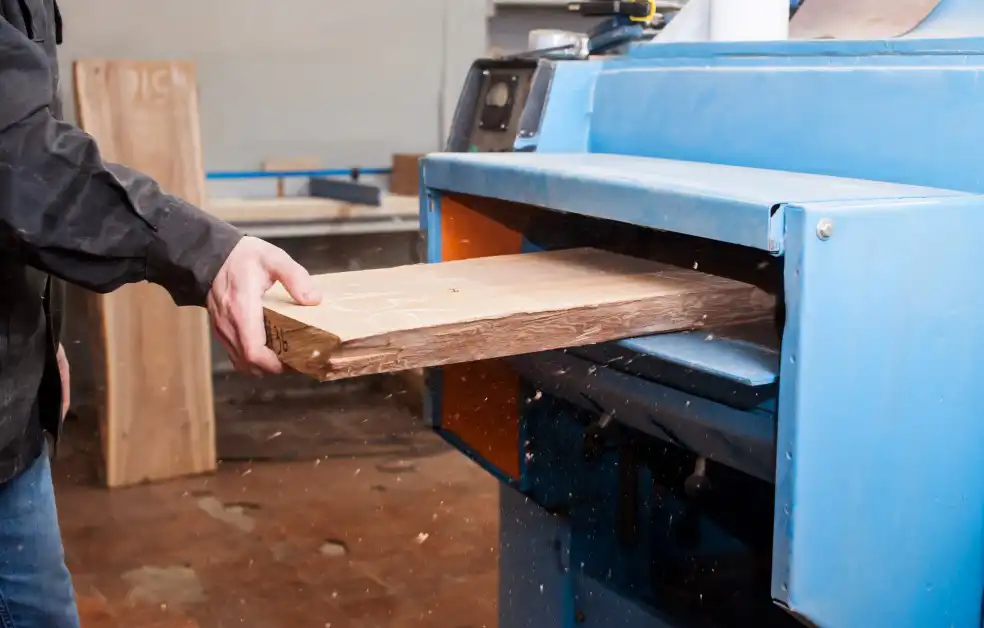Hand planer vs Thickness planer
To choose between a hand planer vs thickness planer, you must consider each tool’s features. Examine the characteristics of each planer tool to see which ones are right for you. A hand planer is a tool used to plane or smooth wood. A thickness planer is a tool that you can use to plane wood, but it can also be used to thickness, or resize, wood.
Hand planers are generally used for smaller jobs, such as smoothing the edge of a wood or taking off a small amount of material. Thickness planers are better suited for larger jobs, such as removing a lot of material from a piece of wood or thicknessing a board.
When deciding which tool to use, you should consider the size of the job and the amount of material you need to remove.
Hand planer
A hand planer is a small, handheld tool used to smooth wood. The operator uses both hands, manual force, and a steel blade. The blade is so thin that it flattens the edges and corners of the wood. It also smooths out frames. Hand planers are not as powerful as thickness planers and can only remove a small amount of material at a time.
You can use a hand planer to achieve a smoother wood surface, trim off swollen corners of a stuck door for smaller wood pieces with heightened accuracy, make radius cuts, create a symmetrical slope plane, and work on parallel wooden surfaces such as tables, doors, or frames. One of its advantages is its portability and ability to work with no electricity or installation.

When using it, grab the knob with one hand and the handle with another. That gives you the grip and steadiness needed to drive it seamlessly across woods. You can also adjust how deep the steel blade cuts from the knob.
The hand planer is portable and can fit into a small tool kit. You can easily take your tool to where the work is. There are two hand planers: a manual hand planer and an electric hand planer. handheld planer
Pros
- Ease of use
- Portable
- The manual version works anywhere
- No installation needed.
Cons
- A wrong move results in injuries and accidents
- Requires physical labor.
Thickness planer
A thickness planer is a larger, more powerful tool that you can use to both smooth wood and thickness it. Thickness plan
A thickness planer is a woodworking machine that trims boards to a consistent thickness throughout their length. This machine works on the desired consistency using the downside as a reference. The down surface must be straight before making a straight board.
Unlike a surface or jointer, a thick planer can produce the first flat surface with a cutter headset on the bed surface. That is so possible in a single pass. The first flat side requires face planing with a jointer or face planing using a planer and jointer sled.

However, the thickness planer has more advantages in that it can produce a board with a consistent thickness, avoids a tapered board, makes passes on each side, and turns the board. It is for the initial preparation of an unplanned board.
A thickness planer serves three purposes that other tools do not. It makes the second face of a board parallel to the other face, smooths rough stock, and reduces stock down to the exact thickness you need.
Pros
- Consistency
- Adjustability
- Accuracy
- Portable
Cons
- It makes splintered edges and pockmarked surfaces
- Cutter head misalignment.
Features
Hand planer
Blade
Always keep the hand planer blade sharp so that the planer cuts. It does not matter if it is still new, it has to be razor-sharp before you put it to use. You do not need more tools and a flexible budget.
Amongst your tools is a sharpening stone or sandpaper. You only need practice holding the iron steady at a 25- to 30-degree angle without rocking it, maintaining firm, downward pressure right over the bevel.
Sharpen first on a wet medium-grit water or oil stone or 220-grit wet/dry sandpaper placed on a dead-flat surface, such as glass. Stroke with a circular motion until you feel a burr on the back of the edge, then flip the iron over to remove the burr by rubbing the back flat on the stone. Repeat the process on a fine stone or finer-grit sandpaper.
Depth Adjustment Wheel
It adjusts the projection of the iron, which affects the depth of cut and the amount of material removed. Turning it clockwise increases the cutting depth; turning it counterclockwise reduces the depth of cut.
Lever Cap Screw
Turning the depth adjustment wheel becomes easy. It holds the blade/chip breaker assembly to the frog. Make sure it is tight enough that the blade remains sturdy during use. When not sure, start with less pressure than you think is necessary and increase it only if you see the blade shifting during use.
Frog
It is attached to the iron body of the plane with machine screws, holding the blade/chip breaker assembly at the cutting angle. It adjusts forward and back to fine-tune the gap between the blade’s cutting edge and the front of the mouth. Adjust laterally for the cutting edge to be square to the sole. The cast metal frog on each model holds the entire cutting iron assembly comprising both cutting and cap irons (Paulsellers.com)
Thickness planer

Cutterhead
A cutter head contains the cutting knives.
Rollers
A set of rollers draw the board through the machine.
Table
The table is adjustable relative to the cutter head to control the resultant thickness of the board. Some portable thickness planers differ in the table fixed, and the cutter head/feed roller assembly is adjusted.
Motors
Industrial thickness planers accept wide boards and remove large amounts of material in a single pass. These machines have powerful motors and are of heavy construction. Recently, a range of lightweight, portable thickness planers have become available, which use affordable but noisy, universal motors rather than induction motors and are much less expensive than industrial versions.
Table
The table is set to the desired height before the machine is on. The board is fed into the machine until it contacts the in-feed roller, gripping it, draws it into the machine, and passes the rotating cutter head.
To finish a flat board of uniform thickness along its length, start with a board with at least one flat reference face. The board is fed with the face flat on the table. The cutter head removes material from the opposite face making it parallel to the reference face.
The reference face is created by first passing the board over a jointer. If the lower face is not flat, the feed roller pressure pressing the board against the table will deform the board, which will spring back as it leaves the machine, resulting in a non-flat upper surface.
Knives
The knives remove material on the way through, and the outfeed roller pulls the board through, ejecting it from the machine at the end of the pass.
Hand planer vs a thickness planer Features
Motors
Unlike a hand planer, a thickness planer works with external power from batteries or electricity. The motor on a thickness planer is heavily constructed, making it heavier.
Blades
You do not need more tools and a flexible budget when working with a hand planer. Use a sharpening stone or sandpaper. A thickness planer uses knives. They remove stock through, and the outfeed roller pulls the board through and ejects it from the machine at the end of the pass.
What could be better
Hand planer
- Due to its portability, you can easily have accidents of any unintended moves. More weight on the planer could have been easier to work with.
- Manual work requires more effort and high accuracy. It could have been a bit more advanced.
Thickness planer
- The planer should be effective enough to avoid splintered edges and pockmarked surfaces.
- You should avoid the cutter head misalignment.
Similar Features
- They both remove material.
- They are portable.
Key Differences
- A thickness planer allows you to size boards to the correct thickness accurately and easily, unlike the hand planer.
- A thickness planer is more accurate than a hand planer.
The verdict
You can use a hand planer instead of a thickness planer if you’re working on a small project and don’t mind the extra effort required to achieve a smooth finish. If you need accuracy and consistency, go for a thickness planer.
If you’re working on a big project requiring uniform thickness boards, you can use a thickness planer instead of a hand planer. If you need portability and flexibility, go for a hand planer.
To get rid of a tapered board, maintain the straightness on a double surface, cut the wood surface to your desired thickness and create boards with parallel surfaces; go for the thickness planer. They are both great tools and offer unique benefits. Go for one that would help your desired piece.
- Grain and Sheen: Teak Oil versus Danish Oil Uncovered - January 10, 2024
- The Cherry on Top: Crafting the Perfect Cutting Board - January 9, 2024
- Polyurethane Water-Based vs Oil-Based: Choosing the Right Finish - January 8, 2024
